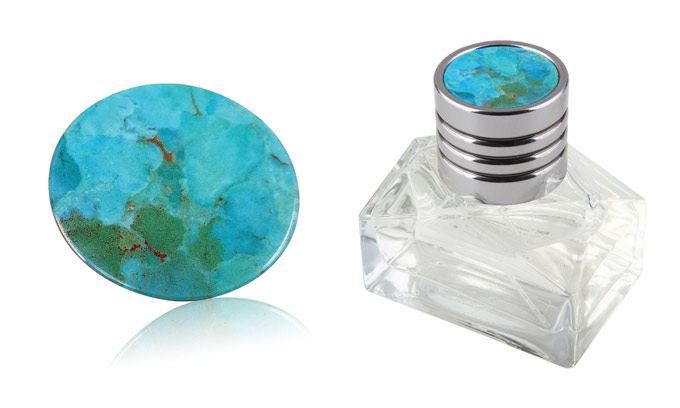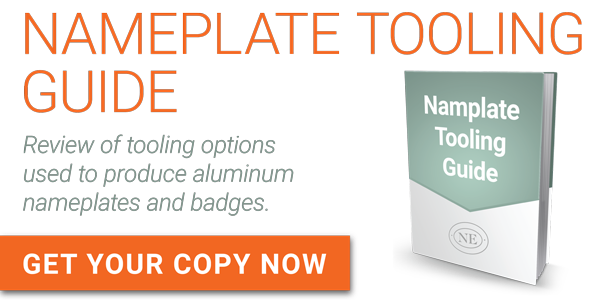Rolled Edge to Hide the Silver Edge for Aluminum Nameplates and Trim
Hiding the Silver Edge
Aluminum nameplates have a visible silver edge when cut out from the sheet. Recently we reviewed how to hide that silver edge by designing a recess into the product housing. Sometimes this is not possible. What can be done to solve this issue? Another option is to roll the edge of the aluminum nameplate or trim so the ability to see the silver edge is minimized.
A rolled edge is created at the same time the individual part is blanked out of the decorated aluminum sheet. This keeps the number of tooling operations at a minimum, saving you money as well as being efficient in the production of your part. The subtle form over creates a softened edge when the part is blanked out of the hard tool and little to no silver material showing when assembled to the final product. It creates a finished edge instead of the raw blank typically seen. This makes the decorated part able to sit on top of a product without need to redesign housing to incorporate a recess.
A rolled edge is not meant to take the place of a formed over or wiped edge. Each design should be reviewed with tooling for best recommendation based on your unique project.
Considerations
Some things to keep in mind as you consider using a rolled edge for your design have been pulled from the Aluminum Nameplate Tooling Guide and are listed below. Each point can be reviewed in more specific detail with your unique project on a case by case scenario.
• Compatible with aluminum thickness from .012" - .032".
• Rolled edge is subtle with approximate roll over length of .029" (0.75 mm). As thickness of the aluminum increases, the more subtle the appearance of the rolled edge.
• Attachment to the end product can be achieved with pressure sensitive adhesive.
• Combine with additional tooling operations including piercing and embossing as appropriate to complete the design and complement your end product.
Now that you have reviewed information on using a rolled edge to hide the silver of the aluminum on a nameplate, how will this fit with your next design?
Subscribe to Nameplate Blog
- 2021 (1)
- 3D (4)
- Adhesives (11)
- Aluminum (129)
- Aluminum In-mold (9)
- Aluminum Trim (41)
- Anodize (4)
- Appliance (12)
- Appliqué (5)
- Archive (35)
- Artwork Submission (4)
- Assembly (6)
- Automotive (35)
- Backlit (5)
- Boats (6)
- Brass (8)
- Brushed Aluminum (19)
- Carbon Fiber (2)
- Classic (1)
- Coined (5)
- Color Development (25)
- Computers (13)
- Cosmetics (24)
- Custom Patterns (11)
- Customization (16)
- Customized Patterns on Aluminum (2)
- Debossing (13)
- Diamond Cut (22)
- Digital Printing (2)
- ebook (4)
- Electronics (23)
- Embossing (53)
- Etched (20)
- Exterior (9)
- FAQ (29)
- Faux Finish (1)
- Faux Finishes (7)
- Favorite Nameplate (20)
- Furniture (9)
- Gauges (5)
- Gloss (4)
- Hang Tag (1)
- IDSA (1)
- In-mold Decoration (5)
- Individual Letters (7)
- Inlay (1)
- Key Fob (1)
- Labels (10)
- Large Vehicle (4)
- Laser Etch (2)
- Lithography (3)
- Match Box Cover (6)
- Materials and Processes (118)
- Mechanical Finishes (51)
- Medical Equipment (10)
- Metallic (8)
- Motorcycle (11)
- Nameplate (175)
- Nameplate Examples (54)
- Nameplate Tools (7)
- Outdoor Equipment (4)
- Overlay (7)
- Packaging (15)
- Patina Finish (3)
- Plastic (1)
- Plastic Trim (3)
- Point of Purchase (8)
- Polycarbonate (10)
- Process Color (16)
- Promotional Products (38)
- Prototypes (2)
- Recreational Vehicles (6)
- Resources (11)
- Safety Labels (2)
- Selective Patterns (10)
- Sill Plate (6)
- Sports Equipment (9)
- Stainless Steel (17)
- stock dies (10)
- Surfaces (4)
- Sustainability (1)
- Technical (1)
- Telecommunications (9)
- Testing (3)
- Texture (15)
- Top 10 (9)
- Woodgrain (2)








